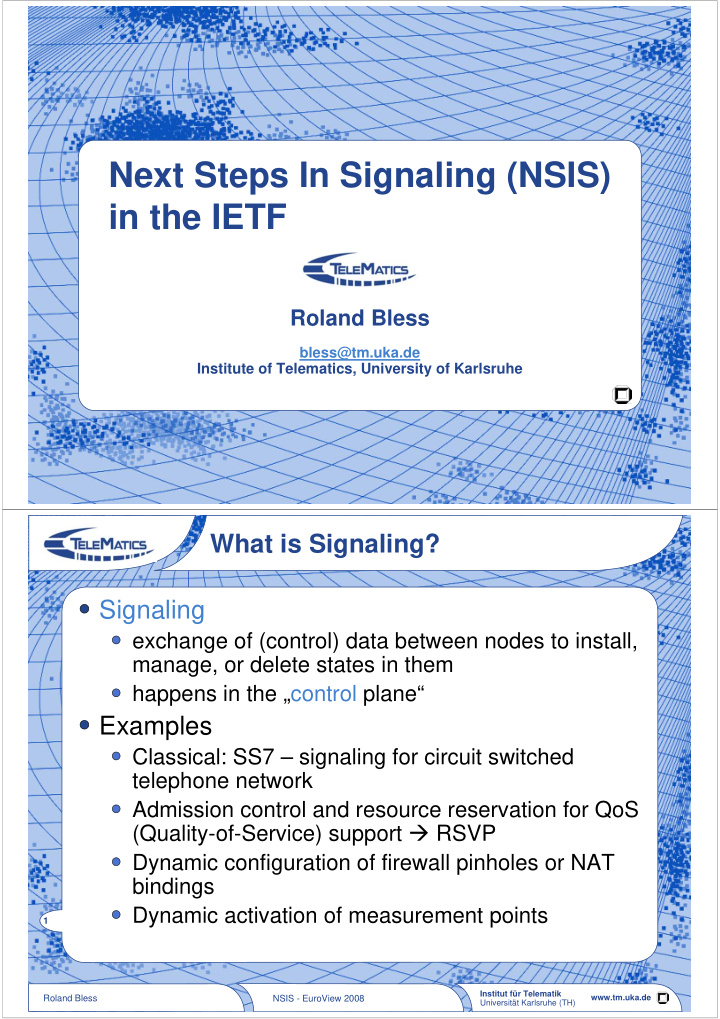



Next Steps In Signaling (NSIS) in the IETF Roland Bless bless@tm.uka.de Institute of Telematics, University of Karlsruhe What is Signaling? Signaling exchange of (control) data between nodes to install, manage, or delete states in them happens in the „control plane“ Examples Classical: SS7 – signaling for circuit switched telephone network Admission control and resource reservation for QoS (Quality-of-Service) support � RSVP Dynamic configuration of firewall pinholes or NAT bindings Dynamic activation of measurement points 1 Institut für Telematik www.tm.uka.de Roland Bless NSIS - EuroView 2008 Universität Karlsruhe (TH)
Next Steps in Signaling (NSIS) IETF Working Group (created 2001) controls resources in IP layer (e.g., router) Goals: (at first mainly QoS signaling in focus) Interworking between different QoS solutions Simplified solution for QoS signaling Support of mobility and wireless next generation networks NSIS Requirements [RFC 3726] (2004) 2 Institut für Telematik Roland Bless NSIS - EuroView 2008 www.tm.uka.de Universität Karlsruhe (TH) NSIS Approach Lessons learned from RSVP offered no efficient support of unicast reservations used for various unforeseen purposes / signaling applications mobility support required Assumptions path-coupled signaling: signaling messages follow data path normal routing (no QoS routing or load balancing etc.) no multicast support considered (at first) 3 Institut für Telematik www.tm.uka.de Roland Bless NSIS - EuroView 2008 Universität Karlsruhe (TH)
NSIS – Two Layer Split NSIS Signaling Signaling Signaling Signaling Application specific Signaling Application 1 Application 2 signaling protocol Application 1 Application 2 Layer logic (QoS) (NAT FW) (QoS) (NAT FW) Protocol (NSLP) Routing of flow-based signaling messages � next node discovery Signaling Message Transport Signaling Message Transport � signaling message transport NSIS � allows reuse of Transport existing transport Layer TLS and security Protocol protocols (NTLP) UDP TCP SCTP DCCP UDP TCP SCTP DCCP IPsec 4 IPv4 or IPv6 IPv4 or IPv6 Institut für Telematik Roland Bless NSIS - EuroView 2008 www.tm.uka.de Universität Karlsruhe (TH) NTLP: GIST Features General Internet Signaling Transport (GIST) Protocol Common signaling transport service for different signaling applications Simple message-by-message transport service conveyed contents are transparent for GIST does not handle signaling application state Discovery and management of signaling message routes Provides Session-ID – supports mobility Datagram or Connection Mode for message transfer Establishment of signaling message associations (soft state) Simple protection against DoS 5 Institut für Telematik www.tm.uka.de Roland Bless NSIS - EuroView 2008 Universität Karlsruhe (TH)
NTLP/NSLP Scenario NSLP NSLP NSLP NSLP NSLP A A B A /B A /B GIST GIST GIST GIST GIST Initiator Forwarder Forwarder Responder Host Router 1 Router 2 Router 3 Router 4 Host not NSIS supports aware only signaling application B 6 Institut für Telematik Roland Bless NSIS - EuroView 2008 www.tm.uka.de Universität Karlsruhe (TH) NSLPs QoS NSLP RSVP-like functionality (but unicast support only) Sender and receiver initiated reservations Independent of specific QoS models such as IntServ or DiffServ Messages RESERVE: creates modifies or deletes reservation state QUERY: Probing RESPONSE: Reply to RESERVE or QUERY NAT/FW NSLP Dynamic configuration of NATs and/or Firewalls along a data path Establishing bindings 7 Controlled opening of firewall pinholes Institut für Telematik www.tm.uka.de Roland Bless NSIS - EuroView 2008 Universität Karlsruhe (TH)
WG Status Main specs now “finished” GIST QoS NSLP NATFW/NSLP QSPEC Several freely available interoperable implementations, e.g., NSIS-ka: https://projekte.tm.uka.de/trac/NSIS Uni Göttingen: FreeNSIS Must strive for deployment now: assure that protocols get implemented by vendors and 8 used by applications Institut für Telematik Roland Bless NSIS - EuroView 2008 www.tm.uka.de Universität Karlsruhe (TH) Conclusions and Outlook NSIS: New and flexible framework for signaling protocols in the IP layer General signaling message transport by GIST Different signaling applications: NAT/FW, QoS Extensible: Explicit Signaling Target MRM allows path- decoupled signaling Used in ScaleNet QoS Architecture Probably used in EU project 4WARD: Virtual Network Configuration NSLP 9 Institut für Telematik www.tm.uka.de Roland Bless NSIS - EuroView 2008 Universität Karlsruhe (TH)
Recommend
More recommend